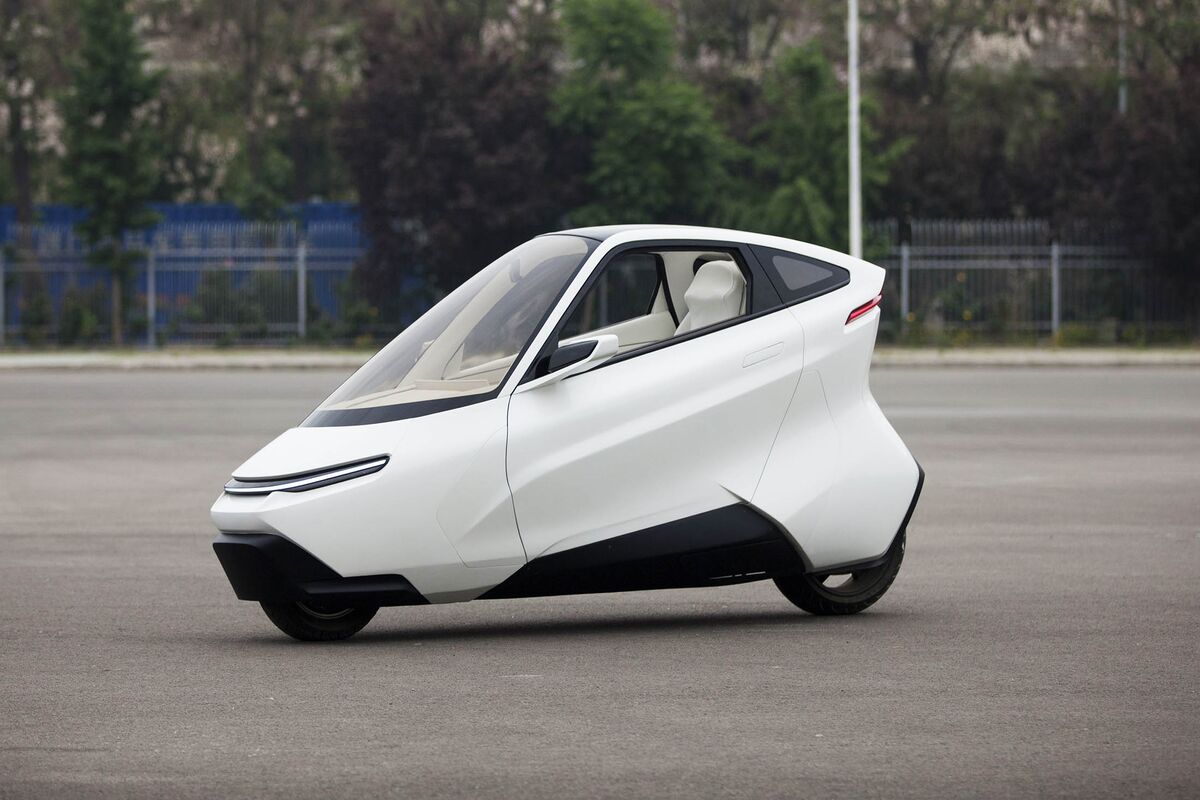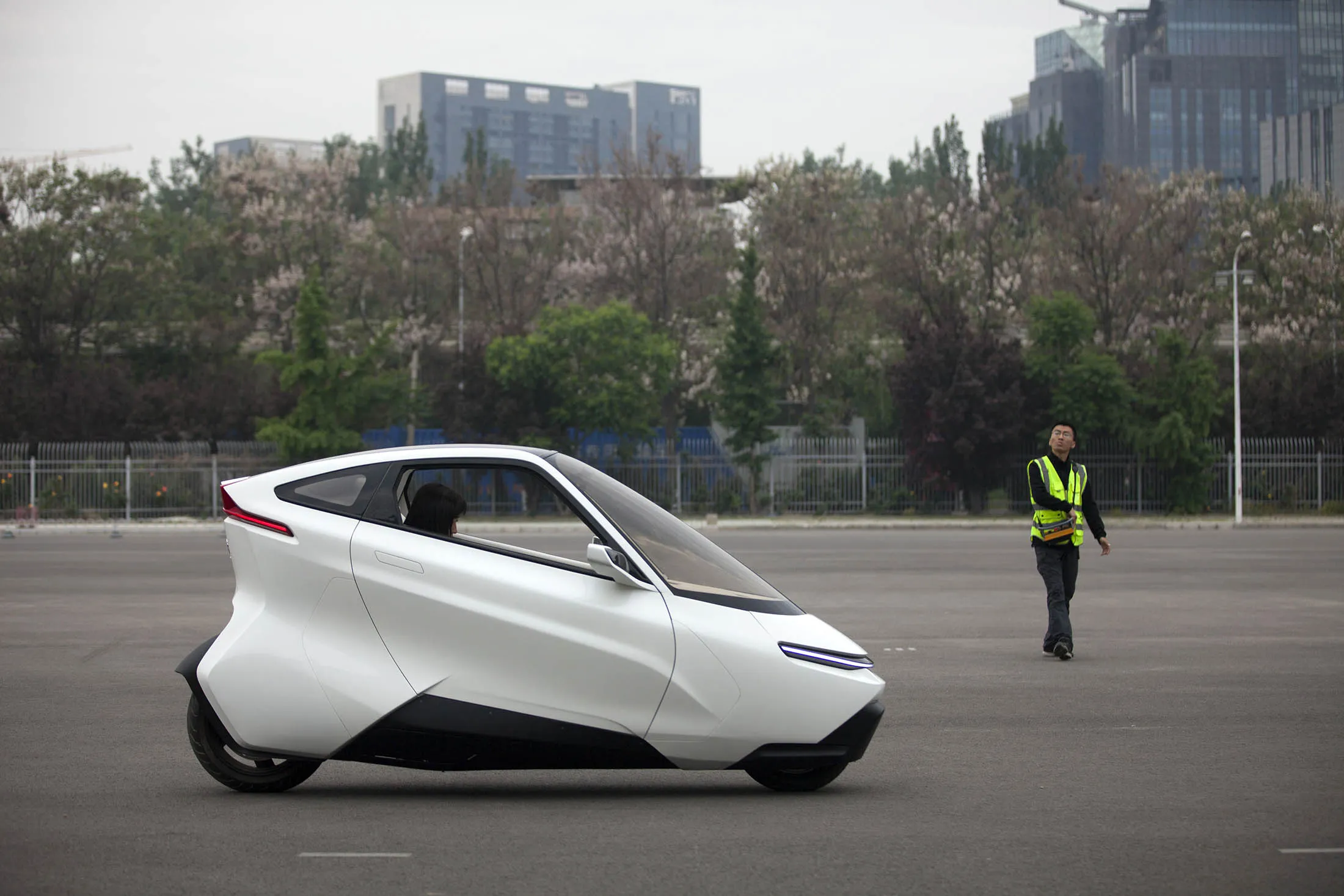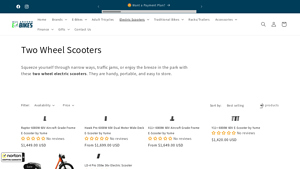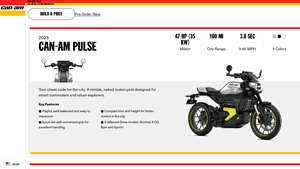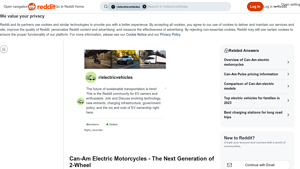Introduction: Navigating the Global Market for two wheel electric vehicle
In an era where urban congestion and environmental concerns are at the forefront of global discussions, sourcing two-wheel electric vehicles (EVs) presents a unique opportunity for international B2B buyers. The rapid evolution of electric mobility is not just a trend; it is a necessity driven by the demand for sustainable transport solutions. However, navigating this burgeoning market can be challenging. This guide aims to demystify the complexities associated with two-wheel electric vehicles, covering various types, applications, and the nuances of supplier vetting.
From electric scooters to advanced gyro-stabilized motorcycles, the scope of this guide will provide insights into the latest innovations and their practical applications in diverse markets, particularly in Africa, South America, the Middle East, and Europe. Understanding the cost implications and operational efficiencies of these vehicles will empower B2B buyers to make informed purchasing decisions that align with their operational needs and sustainability goals.
By equipping buyers with comprehensive knowledge about the features, benefits, and potential pitfalls of different two-wheel electric vehicles, this guide serves as a vital resource for businesses looking to integrate cutting-edge transportation solutions into their fleets. The information provided will enable you to strategically source vehicles that not only meet regulatory standards but also enhance your competitive edge in the global marketplace.
Understanding two wheel electric vehicle Types and Variations
| Type Name | Key Distinguishing Features | Primary B2B Applications | Brief Pros & Cons for Buyers |
|---|---|---|---|
| Electric Motorcycles | High speed, motorcycle-like handling, longer range | Delivery services, ridesharing, personal transport | Pros: Speed and efficiency; Cons: Higher initial investment. |
| Electric Scooters | Compact design, lower speed, lightweight | Urban commuting, short-distance travel | Pros: Cost-effective; Cons: Limited range and power. |
| Self-Balancing Electric Vehicles | Gyro-stabilization, enclosed design, family-friendly | Urban transport, rental services | Pros: Enhanced safety and stability; Cons: New technology may require education. |
| Electric Dirt Bikes | Off-road capability, robust design, powerful motors | Recreational rental, outdoor sports | Pros: Versatile and durable; Cons: Heavier and less suited for urban environments. |
| Electric Mini Bikes | Retro style, smaller frame, designed for casual use | Leisure activities, youth markets | Pros: Fun and engaging; Cons: Limited practicality for adult users. |
What Are the Key Characteristics of Electric Motorcycles for B2B Buyers?
Electric motorcycles are designed for high performance, often featuring powerful motors that allow for speeds exceeding 100 mph. They offer a longer range compared to other two-wheeled options, making them suitable for delivery services and ridesharing applications. B2B buyers should consider the initial investment versus the potential savings on fuel and maintenance over time, as well as the appeal of electric motorcycles in urban markets.
How Do Electric Scooters Serve Urban Commuting Needs?
Electric scooters are compact and lightweight, making them ideal for navigating congested urban environments. With a maximum speed typically around 15-30 mph, they cater to short-distance travel and are popular among commuters. B2B buyers can find value in their affordability and ease of use, though they should be mindful of the limited range and power for longer trips.
What Are the Advantages of Self-Balancing Electric Vehicles for Urban Transport?
Self-balancing electric vehicles utilize advanced gyro-stabilization technology, providing enhanced safety and stability. These vehicles can comfortably seat multiple passengers, making them suitable for urban transport and rental services. B2B buyers should evaluate the technological investment required, as educating users on this newer technology can be necessary, but the potential for reduced accidents may justify this effort.
Why Choose Electric Dirt Bikes for Recreational Rentals?
Electric dirt bikes are designed for off-road use, featuring robust construction and powerful motors for challenging terrains. They are ideal for recreational rentals and outdoor sports businesses. Buyers should assess the versatility and durability of these bikes, though they may be heavier and less suitable for urban commuting, which could limit their market appeal in densely populated areas.
How Do Electric Mini Bikes Fit into the Youth Market?
Electric mini bikes present a retro style and are designed primarily for casual use, appealing to younger demographics. They are fun and engaging, making them attractive for leisure activities and youth markets. B2B buyers should consider their limited practicality for adult users, as well as potential safety concerns, but they can serve as a unique offering in recreational settings.
Key Industrial Applications of two wheel electric vehicle
| Industry/Sector | Specific Application of Two Wheel Electric Vehicle | Value/Benefit for the Business | Key Sourcing Considerations for this Application |
|---|---|---|---|
| Delivery Services | Last-Mile Delivery Solutions | Faster delivery times and reduced operational costs | Battery range, load capacity, and serviceability in urban environments |
| Tourism and Recreation | Guided City Tours with Electric Scooters | Enhanced customer experience and eco-friendly transportation options | Safety features, charging infrastructure, and maintenance support |
| Urban Mobility | Commuter Services for Public Transportation | Cost-effective and sustainable transport solution for urban areas | Compliance with local regulations, vehicle stability, and comfort |
| Emergency Services | Quick Response Units for Medical and Emergency Personnel | Improved response times in congested areas | Reliability, speed, and integration with existing emergency systems |
| Agriculture | Farm Maintenance and Logistics | Efficient movement around large agricultural areas | Durability, battery life, and terrain adaptability |
How are Two Wheel Electric Vehicles Used in Delivery Services?
In the delivery services sector, two-wheel electric vehicles (EVs) are increasingly utilized for last-mile delivery solutions. They are particularly effective in urban settings where traffic congestion is common. By providing a quick and efficient means of transport, these vehicles help businesses enhance their delivery speeds while significantly cutting operational costs associated with fuel and maintenance. For international buyers, key considerations include the vehicle’s battery range and load capacity, ensuring that they can handle the demands of urban delivery routes effectively.
What Role Do Two Wheel Electric Vehicles Play in Tourism and Recreation?
Two-wheel electric vehicles are transforming the tourism and recreation industry by offering guided city tours on electric scooters. This application not only provides tourists with an enjoyable way to explore but also promotes eco-friendly travel. The unique experience appeals to environmentally conscious travelers and can enhance the overall customer experience. Buyers in this sector should prioritize safety features, availability of charging infrastructure, and reliable maintenance support to ensure a smooth operation throughout the tourist season.
How Do Two Wheel Electric Vehicles Contribute to Urban Mobility?
In urban mobility, two-wheel electric vehicles serve as a cost-effective and sustainable transport solution. They can be integrated into public transportation systems to provide commuters with an alternative means of travel, reducing reliance on cars. This shift leads to decreased congestion and lower emissions in cities. B2B buyers need to consider compliance with local regulations, as well as the vehicle’s stability and comfort, to ensure a positive user experience.
How Are Two Wheel Electric Vehicles Used in Emergency Services?
Two-wheel electric vehicles are increasingly being adopted by emergency services for quick response units. Their agility allows emergency personnel to navigate congested urban environments swiftly, improving response times during critical situations. This capability can be vital in saving lives and managing emergencies more effectively. Buyers should focus on the reliability and speed of these vehicles, as well as their ability to integrate with existing emergency response systems, ensuring they meet the high demands of this sector.
What Applications Exist for Two Wheel Electric Vehicles in Agriculture?
In the agricultural sector, two-wheel electric vehicles are utilized for farm maintenance and logistics. They facilitate the efficient movement of personnel and equipment across expansive farmland, which can enhance productivity. These vehicles can help farmers save on fuel costs and reduce their carbon footprint. When sourcing, buyers should prioritize durability, battery life, and the vehicle’s ability to handle various terrains, ensuring that they can withstand the rigors of agricultural environments.
3 Common User Pain Points for ‘two wheel electric vehicle’ & Their Solutions
Scenario 1: Limited Range and Charging Infrastructure Challenges
The Problem: One of the foremost concerns for B2B buyers considering two-wheel electric vehicles (EVs) is the limited range these vehicles typically offer compared to traditional vehicles. In regions such as Africa and South America, where charging infrastructure is often underdeveloped, businesses fear that their fleets may not meet operational needs. This can lead to downtime, increased operational costs, and ultimately, decreased productivity.
The Solution: To effectively address the range and infrastructure limitations, B2B buyers should prioritize sourcing two-wheel electric vehicles equipped with advanced battery technology that offers longer ranges per charge. Look for models that provide at least 100 miles on a single charge, as this can significantly enhance usability for daily commutes and logistics. Furthermore, businesses should consider investing in mobile charging solutions or forming partnerships with local charging station providers to bolster the charging infrastructure. Collaborating with local governments or organizations to develop a network of charging stations can also be a strategic move, ensuring that your fleet has access to necessary charging facilities and enhancing overall operational efficiency.
Scenario 2: Safety Concerns in Varied Environments
The Problem: Safety remains a critical concern for businesses deploying two-wheel electric vehicles, especially in urban areas with heavy traffic or less than optimal road conditions. B2B buyers worry about the potential for accidents, which could result in injuries and liability issues, damaging their brand reputation and leading to increased insurance costs.
The Solution: To mitigate safety concerns, B2B buyers should focus on sourcing two-wheel electric vehicles that incorporate advanced safety features. Look for models equipped with stability control systems, anti-lock braking systems (ABS), and reinforced chassis designs that enhance rider protection. Additionally, consider training programs for employees that emphasize safe riding practices and awareness of road conditions. By investing in high-quality vehicles and comprehensive safety training, businesses can significantly reduce the risk of accidents, ensuring a safer environment for their riders while also protecting their investments.
Scenario 3: Maintenance and Operational Costs
The Problem: Another prevalent pain point for B2B buyers is the uncertainty surrounding maintenance and operational costs of two-wheel electric vehicles. Businesses often fear that while the initial purchase price may be lower than traditional vehicles, unforeseen maintenance issues could lead to escalating costs that diminish the financial benefits of switching to electric.
The Solution: To navigate maintenance concerns, B2B buyers should conduct thorough research on the durability and reliability of the electric vehicle models they are considering. Prioritize manufacturers that offer comprehensive warranties and have a solid reputation for customer service and support. It’s also advisable to analyze the total cost of ownership (TCO) of the vehicles, factoring in potential savings from reduced fuel costs and lower maintenance requirements of electric engines. Establishing a relationship with a reliable local service provider specializing in electric vehicles can also help in managing maintenance proactively. By selecting robust models and fostering a good service relationship, businesses can effectively control maintenance costs and maximize the benefits of their investment in two-wheel electric vehicles.
Strategic Material Selection Guide for two wheel electric vehicle
What Are the Key Materials for Two-Wheel Electric Vehicles?
When selecting materials for two-wheel electric vehicles (EVs), it is essential to consider their properties, performance, and suitability for various applications. This analysis focuses on four common materials: aluminum, steel, carbon fiber, and thermoplastics. Each material presents unique advantages and challenges that can impact the design, manufacturing, and overall performance of the vehicle.
How Does Aluminum Benefit Two-Wheel Electric Vehicles?
Aluminum is widely used in the construction of two-wheel electric vehicles due to its excellent strength-to-weight ratio and corrosion resistance. It typically has a temperature rating of up to 600°F (315°C) and can withstand moderate pressure.
Pros: Aluminum is lightweight, which enhances the vehicle’s efficiency and range. It is also relatively easy to manufacture and can be extruded or molded into complex shapes, making it suitable for various components, including frames and body panels.
Cons: While aluminum is durable, it is not as strong as steel, which may necessitate thicker sections for certain applications, potentially increasing weight. Additionally, the cost of aluminum can be higher than that of steel, impacting overall production expenses.
Impact on Application: Aluminum is compatible with various media, including electric components and battery systems. However, international buyers should consider the need for protective coatings to enhance corrosion resistance, particularly in humid or saline environments.
What Role Does Steel Play in Two-Wheel Electric Vehicles?
Steel remains a popular choice for structural components in two-wheel electric vehicles due to its high strength and durability. It typically offers a temperature rating of around 800°F (427°C) and excellent pressure resistance.
Pros: Steel is cost-effective and widely available, making it an attractive option for manufacturers looking to minimize costs. Its strength allows for thinner sections, which can reduce overall vehicle weight.
Cons: Steel is heavier than aluminum and can be prone to corrosion if not properly treated. Manufacturing processes for steel can also be more complex, requiring additional steps for welding and finishing.
Impact on Application: Steel is suitable for components that require high strength, such as the chassis and suspension systems. Buyers in regions with stringent safety regulations should ensure compliance with relevant standards, such as ASTM or DIN.
How Does Carbon Fiber Enhance Performance in Two-Wheel Electric Vehicles?
Carbon fiber is increasingly being adopted in high-performance two-wheel electric vehicles due to its exceptional strength-to-weight ratio and rigidity. It can withstand temperatures up to 350°F (177°C) and offers excellent fatigue resistance.
Pros: The lightweight nature of carbon fiber significantly improves acceleration and handling, making it ideal for performance-oriented models. It also provides superior corrosion resistance compared to metals.
Cons: The primary drawback of carbon fiber is its high cost, which can be a barrier for mass-market applications. Additionally, the manufacturing process can be complex, requiring specialized equipment and expertise.
Impact on Application: Carbon fiber is particularly beneficial for components like body panels and structural reinforcements. International buyers should be aware of the need for specialized manufacturing facilities and compliance with quality standards.
What Advantages Do Thermoplastics Offer for Two-Wheel Electric Vehicles?
Thermoplastics are gaining traction in the two-wheel electric vehicle market due to their versatility and lightweight properties. They can be molded into intricate shapes and typically have a temperature rating of around 200°F (93°C).
Pros: Thermoplastics are cost-effective and can be produced in large quantities, making them suitable for various applications, including interior components and fairings. They also offer good impact resistance and can be recycled.
Cons: While thermoplastics are lightweight, they may not provide the same level of strength as metals, which can limit their use in structural applications. Additionally, they may be susceptible to UV degradation over time.
Impact on Application: Thermoplastics are ideal for non-structural components and can be used in regions with less extreme environmental conditions. Buyers should ensure compliance with relevant safety and environmental standards.
Summary Table of Material Selection for Two-Wheel Electric Vehicles
| Material | Typical Use Case for two wheel electric vehicle | Key Advantage | Key Disadvantage/Limitation | Relative Cost (Low/Med/High) |
|---|---|---|---|---|
| Aluminum | Frames, body panels | Lightweight and corrosion-resistant | Higher cost than steel | Medium |
| Steel | Chassis, suspension systems | High strength and cost-effective | Heavier and prone to corrosion | Low |
| Carbon Fiber | Body panels, structural reinforcements | Exceptional strength-to-weight ratio | High cost and complex manufacturing | High |
| Thermoplastics | Interior components, fairings | Versatile and recyclable | Limited strength for structural use | Low |
This strategic material selection guide provides valuable insights for international B2B buyers, enabling them to make informed decisions when sourcing materials for two-wheel electric vehicles. Understanding the properties, advantages, and limitations of each material is crucial for optimizing performance, cost, and compliance with regional standards.
In-depth Look: Manufacturing Processes and Quality Assurance for two wheel electric vehicle
What Are the Key Manufacturing Processes for Two-Wheel Electric Vehicles?
The manufacturing of two-wheel electric vehicles (EVs) involves several critical stages, each requiring precision and adherence to best practices. Understanding these processes is essential for B2B buyers looking to partner with manufacturers that uphold quality and efficiency.
What Are the Main Stages of Manufacturing Two-Wheel Electric Vehicles?
-
Material Preparation
The initial stage focuses on sourcing and preparing materials. Common materials used include high-strength steel and aluminum for the frame, lithium-ion cells for batteries, and various plastics for body components. Suppliers should ensure that materials meet international standards to guarantee durability and performance. -
Forming
This stage involves shaping materials into desired forms using techniques such as stamping, bending, and welding. Advanced manufacturing technologies, including CNC machining and robotic welding, are often employed to enhance accuracy and reduce production time. The use of lightweight materials is crucial to improving energy efficiency without compromising strength. -
Assembly
The assembly process integrates various components, including the frame, battery, electric motor, and electronics. Modular assembly lines can improve efficiency, allowing for quick adjustments based on production demands. Manufacturers should utilize advanced quality control measures during this phase, such as torque wrenches and alignment tools, to ensure precise assembly. -
Finishing
The finishing stage typically includes painting, coating, and surface treatment to enhance the vehicle’s aesthetics and protect against corrosion. Techniques such as powder coating and electrophoretic deposition are popular due to their durability. This stage also involves final inspections to ensure that the product meets the required specifications and standards.
How Is Quality Assurance Implemented in Two-Wheel Electric Vehicle Manufacturing?
Quality assurance (QA) is critical in the production of two-wheel electric vehicles, ensuring that every unit meets safety and performance standards. Internationally recognized frameworks and industry-specific regulations guide this process.
What International Standards Are Relevant for Quality Assurance?
-
ISO 9001
ISO 9001 is a widely accepted quality management standard that outlines requirements for a quality management system (QMS). Manufacturers seeking certification must demonstrate their ability to consistently provide products that meet customer and regulatory requirements. -
CE Marking
The CE mark indicates compliance with European safety, health, and environmental protection standards. For two-wheel electric vehicles, obtaining CE certification assures B2B buyers that the products adhere to EU directives, which is particularly important for markets in Europe. -
API Standards
The American Petroleum Institute (API) standards may also apply, particularly in the context of lubricants and materials used in electric vehicle manufacturing. Compliance with these standards ensures that materials are of high quality and suitable for their intended application.
What Are the Key Quality Control Checkpoints in Manufacturing?
Quality control (QC) is integrated throughout the manufacturing process, with specific checkpoints ensuring compliance at various stages.
-
Incoming Quality Control (IQC)
During IQC, raw materials and components are inspected upon arrival. This step is crucial for verifying that materials meet specified quality standards before they enter the production line. -
In-Process Quality Control (IPQC)
IPQC occurs throughout the manufacturing process, with inspections at critical stages such as forming and assembly. This includes checks for dimensional accuracy, component fit, and assembly integrity. Regular monitoring helps identify defects early, minimizing the risk of faulty products reaching the market. -
Final Quality Control (FQC)
FQC is conducted before the products leave the factory. It involves comprehensive testing of finished vehicles, including performance tests, safety evaluations, and aesthetic inspections. Documentation of the FQC results is essential for transparency and accountability.
What Common Testing Methods Are Used in Quality Control?
To ensure that two-wheel electric vehicles meet performance and safety standards, manufacturers employ various testing methods, including:
- Functional Testing: Verifying that all electronic systems, including the motor and battery management systems, operate correctly.
- Durability Testing: Assessing the vehicle’s performance under various conditions, such as extreme temperatures and rough terrains, to ensure reliability.
- Safety Testing: Conducting crash tests and stability assessments to validate the vehicle’s safety features, particularly for models utilizing advanced technologies like gyro-stabilization.
How Can B2B Buyers Verify Supplier Quality Control Practices?
B2B buyers must conduct thorough due diligence when selecting suppliers for two-wheel electric vehicles. Here are several strategies to ensure quality:
-
Supplier Audits
Regular audits of potential suppliers can reveal their manufacturing capabilities and quality control processes. Auditors should assess compliance with international standards and review documentation related to their QMS. -
Quality Reports
Requesting quality assurance reports provides insight into the supplier’s QC performance. These reports should detail inspection results, defect rates, and corrective actions taken in response to quality issues. -
Third-Party Inspections
Engaging third-party inspection agencies can add an additional layer of assurance. These organizations can provide impartial assessments of the manufacturing process and quality control measures, ensuring that the supplier meets industry standards.
What Are the Nuances of Quality Control for International Buyers?
When sourcing two-wheel electric vehicles from international suppliers, particularly in regions like Africa, South America, the Middle East, and Europe, buyers should be aware of several nuances:
- Regulatory Compliance: Different regions may have specific regulations that impact the design and manufacturing of electric vehicles. Familiarizing oneself with local regulations can prevent costly compliance issues.
- Cultural Differences in Quality Standards: Standards for quality and safety may vary between countries. Buyers should ensure that their suppliers are equipped to meet both local and international quality expectations.
- Logistics and Supply Chain Considerations: Delays in shipping or customs clearance can affect the quality of materials. Buyers should work closely with suppliers to understand their logistics strategies and mitigate potential risks.
In conclusion, a comprehensive understanding of the manufacturing processes and quality assurance measures for two-wheel electric vehicles is essential for B2B buyers. By focusing on key manufacturing stages, adhering to international standards, and implementing robust quality control practices, buyers can ensure they partner with reliable suppliers that deliver high-quality electric vehicles tailored to their market needs.
Practical Sourcing Guide: A Step-by-Step Checklist for ‘two wheel electric vehicle’
In the rapidly evolving market for two-wheel electric vehicles (EVs), B2B buyers face the challenge of selecting the right products and suppliers to meet their business needs. This practical sourcing guide provides a comprehensive checklist to streamline the procurement process, ensuring informed decisions and successful partnerships.
Step 1: Define Your Technical Specifications
Establishing clear technical specifications is crucial for aligning your purchasing decisions with operational needs. Consider factors such as battery capacity, range per charge, weight, and safety features. This clarity will help you shortlist products that meet your performance criteria and market demands.
Step 2: Research Market Trends and Regulatory Requirements
Stay informed about the latest trends and regulations in the two-wheel EV market, particularly in your target regions like Africa, South America, the Middle East, and Europe. Understanding local regulations, such as safety standards and environmental policies, will ensure compliance and enhance market acceptance for your products.
Step 3: Evaluate Potential Suppliers
Before committing to a supplier, conduct thorough evaluations. Request company profiles, certifications, and case studies that demonstrate their experience in the EV sector. Look for suppliers that have a proven track record in your specific market, as this can significantly reduce risks associated with quality and reliability.
- Key Considerations:
- Review customer testimonials and references.
- Assess their manufacturing capabilities and technology.
Step 4: Assess Product Quality and Performance
Quality assurance is paramount when selecting two-wheel EVs. Request samples for testing and evaluate performance metrics such as speed, charging time, and durability. Ensure that the products meet industry standards for safety and efficiency to avoid future liabilities.
Step 5: Examine After-Sales Support and Warranty Terms
Strong after-sales support can differentiate suppliers in the competitive EV market. Inquire about warranty terms, maintenance services, and spare parts availability. A reliable supplier should offer comprehensive support to ensure the longevity and optimal performance of the vehicles.
Step 6: Negotiate Pricing and Payment Terms
Once you’ve identified potential suppliers, engage in negotiations to secure favorable pricing and payment terms. Consider bulk purchase discounts, shipping costs, and payment flexibility. Establishing clear financial agreements upfront will help avoid misunderstandings later in the procurement process.
Step 7: Develop a Risk Management Strategy
Finally, create a risk management plan to address potential challenges such as supply chain disruptions, regulatory changes, or shifts in market demand. This strategy should include contingency plans and a framework for regular communication with suppliers to adapt to any unforeseen circumstances.
By following this step-by-step checklist, B2B buyers can effectively navigate the procurement process for two-wheel electric vehicles, ensuring they make informed decisions that align with their business goals and market dynamics.
Comprehensive Cost and Pricing Analysis for two wheel electric vehicle Sourcing
What Are the Key Cost Components in Sourcing Two-Wheel Electric Vehicles?
When sourcing two-wheel electric vehicles (2WEVs), understanding the cost structure is crucial for B2B buyers. The primary cost components include:
-
Materials: The choice of materials directly affects the vehicle’s performance and durability. Common materials such as aluminum and high-strength steel are preferred for frames due to their balance of weight and strength. Battery technology also plays a significant role; lithium-ion batteries are currently the standard but can vary in cost based on capacity and supplier.
-
Labor: Labor costs can fluctuate based on geographic location and the complexity of manufacturing processes. Regions with lower labor costs might offer competitive pricing, but this can come at the expense of quality or lead times.
-
Manufacturing Overhead: This includes expenses related to the factory operations, utilities, and indirect labor. Efficient manufacturing processes can help minimize these costs, which is essential for maintaining competitive pricing.
-
Tooling: Initial investments in tooling can be substantial, especially for custom designs. Buyers should consider whether the supplier has the capability to manage tooling costs efficiently or if they will pass these costs onto the buyer.
-
Quality Control (QC): Quality assurance processes ensure that the vehicles meet safety and performance standards. Implementing robust QC measures can increase upfront costs but ultimately reduce long-term warranty and maintenance issues.
-
Logistics: Transportation and distribution costs can significantly impact the overall price. Buyers should evaluate shipping methods, distances, and associated tariffs, especially when sourcing internationally.
-
Margin: Supplier margins vary based on market conditions and competition. Understanding the typical margins in the industry can aid in evaluating supplier proposals.
How Do Price Influencers Affect Two-Wheel Electric Vehicle Sourcing?
Several factors can influence pricing, which B2B buyers should be aware of:
-
Volume/MOQ: Minimum order quantities (MOQs) can lead to cost reductions. Suppliers often provide better pricing for larger orders, making it beneficial for buyers to consolidate purchases when possible.
-
Specifications and Customization: Custom specifications can increase costs due to additional engineering, materials, and production processes. Buyers should weigh the benefits of customization against the associated costs.
-
Materials and Quality Certifications: Higher quality materials and certifications (e.g., ISO, CE) typically command higher prices. Buyers should assess whether the added costs are justified by the expected performance and compliance benefits.
-
Supplier Factors: Supplier reliability, reputation, and financial stability can influence pricing. Established suppliers might offer higher prices, but they may provide better warranties and customer support.
-
Incoterms: The choice of Incoterms can affect the total landed cost. Buyers should understand how terms like FOB (Free On Board) or CIF (Cost, Insurance, and Freight) impact their overall expenditure and risk.
What Negotiation and Cost-Efficiency Tips Should B2B Buyers Consider?
B2B buyers can adopt several strategies to optimize their sourcing process:
-
Negotiate Terms: Engage in open discussions about pricing, payment terms, and delivery schedules. Establishing a collaborative relationship can lead to better terms.
-
Evaluate Total Cost of Ownership (TCO): Consider not just the initial purchase price but also operational costs, maintenance, and potential resale value. A lower upfront cost may not always equate to better long-term value.
-
Understand Pricing Nuances: International buyers should be aware of currency fluctuations, tariffs, and regional demand variations, as these can all impact pricing.
-
Seek Multiple Quotes: Obtaining quotes from various suppliers allows for comparison and can provide leverage in negotiations.
-
Invest in Relationships: Building strong relationships with suppliers can lead to more favorable terms, better communication, and prioritized service.
In summary, understanding the cost structure and price influencers of two-wheel electric vehicles is essential for B2B buyers. By considering these elements and employing strategic negotiation tactics, buyers can optimize their sourcing strategies and secure better deals.
Alternatives Analysis: Comparing two wheel electric vehicle With Other Solutions
In the rapidly evolving landscape of transportation, businesses face a myriad of choices when considering two-wheeled electric vehicles (2WEVs) for their operational needs. Understanding the alternatives available can help international B2B buyers make informed decisions that align with their specific requirements and regional market conditions. This analysis compares 2WEVs against electric scooters and traditional motorcycles, focusing on performance, cost, ease of implementation, maintenance, and best use cases.
Comparison Table
| Comparison Aspect | Two Wheel Electric Vehicle | Electric Scooter | Traditional Motorcycle |
|---|---|---|---|
| Performance | 100+ mph, 170 miles/charge | 15-30 mph, 20-40 miles | 60-120 mph, 150-300 miles |
| Cost | High initial investment | Low to moderate cost | Moderate to high cost |
| Ease of Implementation | Requires infrastructure | Minimal infrastructure | Minimal infrastructure |
| Maintenance | Low due to fewer parts | Low, but battery replacement needed | Moderate, requires regular servicing |
| Best Use Case | Urban commuting, long-distance travel | Short commutes, recreational use | Long-distance travel, leisure riding |
Understanding the Alternatives: Insights for B2B Buyers
What are Electric Scooters and Their Benefits?
Electric scooters are compact, lightweight vehicles designed primarily for short-distance travel. They are typically more affordable than 2WEVs and have lower operational costs. The ease of maneuverability and parking makes them ideal for urban environments where traffic congestion is a concern. However, their limited speed and range might not suit businesses needing to cover longer distances or transport multiple passengers.
How Do Traditional Motorcycles Compare?
Traditional motorcycles offer higher speeds and greater range, making them suitable for long-distance travel and leisure. They are often seen as more versatile for various terrains and riding conditions. However, they come with a higher maintenance burden and operational costs due to more complex mechanical systems. For businesses focused on performance and range, traditional motorcycles might be a better fit, but they lack the eco-friendly advantage of electric alternatives.
Conclusion: Choosing the Right Solution for Your Business Needs
When selecting between two-wheeled electric vehicles, electric scooters, and traditional motorcycles, businesses must weigh their operational requirements against each alternative’s strengths and weaknesses. Factors such as budget, intended use, required performance, and maintenance capabilities will significantly influence the decision-making process. For companies prioritizing sustainability and lower operational costs, 2WEVs present a compelling option, while those requiring higher speeds and longer ranges might lean toward traditional motorcycles. Ultimately, understanding the specific needs of the business and the local market context will guide B2B buyers to the most suitable solution.
Essential Technical Properties and Trade Terminology for two wheel electric vehicle
What Are the Key Technical Properties of Two-Wheel Electric Vehicles?
When evaluating two-wheel electric vehicles (2WEVs), several technical properties are critical to ensuring efficiency, safety, and performance. Understanding these specifications not only assists in making informed procurement decisions but also helps in assessing the long-term value of the investment.
-
Battery Capacity (Ah)
The battery capacity, measured in ampere-hours (Ah), indicates how much energy the battery can store. A higher capacity translates to a longer range per charge, which is vital for end-users in regions with limited charging infrastructure. For B2B buyers, selecting vehicles with optimal battery capacity can minimize operational downtime and improve fleet efficiency. -
Motor Power (W)
The motor power, expressed in watts (W), determines the vehicle’s performance, including acceleration and maximum speed. A higher wattage generally allows for better performance, especially in hilly terrains or during heavy loads. For businesses, understanding motor power helps in selecting vehicles that meet specific operational requirements, ensuring reliability in various conditions. -
Weight-to-Power Ratio
This ratio compares the weight of the vehicle to its motor power, influencing both speed and energy efficiency. A lower weight-to-power ratio typically results in better acceleration and handling. For fleet operators, optimizing this ratio can lead to reduced energy consumption and lower operational costs over time. -
Charging Time (Hours)
Charging time refers to how long it takes to fully charge the battery. Understanding this property is crucial for logistics and operational planning, especially in commercial applications. Shorter charging times can lead to increased vehicle utilization and improved fleet management. -
Range (Miles/Kilometers)
Range indicates how far a vehicle can travel on a single charge. This property is particularly significant for businesses that rely on daily commutes or deliveries. A longer range reduces the frequency of recharging, thereby enhancing productivity and operational efficiency. -
Safety Features
Two-wheel electric vehicles may incorporate advanced safety features such as anti-lock braking systems (ABS), stability control, and reinforced chassis. These features are essential for reducing accident risks, which is critical for businesses prioritizing employee safety and liability management.
What Are Common Trade Terminology and Jargon in the Two-Wheel Electric Vehicle Industry?
Navigating the B2B landscape of two-wheel electric vehicles requires familiarity with specific industry terminology. Here are some essential terms that buyers should understand:
-
OEM (Original Equipment Manufacturer)
An OEM is a company that produces parts and equipment that may be marketed by another manufacturer. Understanding OEM relationships is crucial for buyers looking to source high-quality components and ensure compatibility with existing vehicle systems. -
MOQ (Minimum Order Quantity)
MOQ refers to the smallest quantity of a product that a supplier is willing to sell. Knowing the MOQ helps businesses in budgeting and inventory management, ensuring that they meet supplier requirements without overcommitting resources. -
RFQ (Request for Quotation)
An RFQ is a document sent to suppliers requesting pricing and availability for specific products or services. This process is essential for B2B buyers looking to compare costs and secure the best deals, enabling informed purchasing decisions. -
Incoterms (International Commercial Terms)
Incoterms are a set of predefined international rules that clarify the responsibilities of buyers and sellers in international transactions. Familiarity with these terms is vital for understanding shipping costs, insurance, and risk management, particularly for buyers operating in diverse global markets. -
TCO (Total Cost of Ownership)
TCO encompasses all costs associated with the purchase and operation of a vehicle over its lifespan, including acquisition, maintenance, fuel, and resale. Understanding TCO is crucial for making informed purchasing decisions that align with budgetary constraints and long-term financial goals. -
Regenerative Braking
This technology captures energy typically lost during braking and redirects it to recharge the battery. For B2B buyers, vehicles equipped with regenerative braking systems can enhance energy efficiency and reduce operational costs, making them a more sustainable choice.
By grasping these technical properties and trade terms, B2B buyers can better navigate the complexities of the two-wheel electric vehicle market, making informed decisions that enhance operational efficiency and reduce costs.
Navigating Market Dynamics and Sourcing Trends in the two wheel electric vehicle Sector
What Are the Key Market Dynamics and Trends Influencing Two-Wheel Electric Vehicles?
The two-wheel electric vehicle (2WEV) market is experiencing rapid growth driven by several global factors, including urbanization, the push for sustainable transportation, and technological advancements. With increasing congestion in urban areas, electric scooters and motorcycles offer a convenient, efficient, and eco-friendly alternative for commuters. In regions like Africa, South America, and the Middle East, where public transport infrastructure may be lacking, the adoption of 2WEVs is becoming particularly significant. For instance, countries like Brazil and Vietnam are witnessing a surge in demand due to both economic growth and a young population eager for innovative transport solutions.
Emerging technologies are also transforming the 2WEV landscape. Innovations such as gyro-stabilization, as seen in products like the Lit Motors AEV, enhance safety and maneuverability, appealing to both consumers and businesses looking for reliable transport options. Additionally, the integration of IoT and smart technologies is enabling better fleet management for businesses, making it easier for international buyers to source products that align with their operational needs.
The market is also influenced by changing regulatory frameworks, as governments worldwide implement stricter emissions standards and incentives for electric vehicle adoption. This regulatory support is crucial for B2B buyers looking to invest in sustainable solutions that comply with local laws.
How Is Sustainability Shaping Sourcing Strategies in the Two-Wheel Electric Vehicle Sector?
Sustainability is at the forefront of sourcing strategies for two-wheel electric vehicles, reflecting a broader commitment to reducing environmental impact. As global awareness of climate change grows, businesses are increasingly prioritizing suppliers who adhere to sustainable practices. This includes the use of environmentally friendly materials, such as recycled metals and sustainable batteries, which are essential for minimizing the lifecycle impact of electric vehicles.
Ethical sourcing is equally important, with an emphasis on transparency in supply chains. International buyers must consider suppliers that demonstrate compliance with ethical labor practices and environmentally responsible manufacturing processes. Certifications such as ISO 14001 for environmental management systems and Fair Trade certifications can serve as indicators of a supplier’s commitment to sustainability.
Moreover, the demand for ‘green’ certifications is rising, particularly in regions like Europe, where consumers are more likely to choose products that have clear environmental benefits. This trend is encouraging manufacturers to innovate in their sourcing methods, ensuring that their products not only meet performance standards but also align with the values of eco-conscious buyers.
How Has the Two-Wheel Electric Vehicle Sector Evolved Over Time?
The evolution of the two-wheel electric vehicle sector reflects broader technological advancements and shifting consumer preferences. Initially, electric scooters were seen as niche products, primarily utilized for recreational purposes. However, as battery technology improved and charging infrastructure expanded, these vehicles became more practical for everyday commuting.
The introduction of advanced features, such as regenerative braking and smart connectivity, has further propelled the market. Innovations from companies like Lit Motors and the Hoverboard inventor Shane Chen highlight a trend towards vehicles that combine safety, efficiency, and user-friendly technology. These developments have made two-wheel electric vehicles more appealing to both consumers and businesses, positioning them as viable alternatives to traditional transportation options.
As the market continues to mature, B2B buyers must remain attuned to these trends to make informed sourcing decisions that align with their strategic goals. The focus on sustainability, technological innovation, and evolving consumer preferences will undoubtedly shape the future of the two-wheel electric vehicle sector.
Frequently Asked Questions (FAQs) for B2B Buyers of two wheel electric vehicle
-
How do I choose the right two-wheel electric vehicle for my business needs?
Selecting the appropriate two-wheel electric vehicle (EV) involves assessing your specific requirements, including the intended use (e.g., delivery, commuting), payload capacity, and range. Evaluate the vehicle’s specifications such as speed, battery life, and weight. Additionally, consider factors like local regulations, climate conditions, and available charging infrastructure in your region. Engaging with suppliers for demo rides and seeking testimonials from other businesses can also aid in making an informed decision. -
What are the key features to look for in a two-wheel electric vehicle?
When sourcing two-wheel electric vehicles, prioritize features such as battery capacity (measured in kWh), charging time, weight, and safety technologies like anti-lock braking systems and stability controls. Look for vehicles with high energy efficiency ratings and low maintenance requirements. Additionally, assess the availability of spare parts and the manufacturer’s warranty coverage. Customization options may also be critical depending on your branding and operational needs. -
What is the average lead time for ordering two-wheel electric vehicles from suppliers?
Lead times can vary significantly based on the supplier’s location, production capacity, and order size. Generally, expect a lead time ranging from 4 to 12 weeks for standard orders. Custom orders may take longer, so it’s crucial to communicate your timelines clearly with suppliers. Consider establishing a relationship with manufacturers who can provide faster turnaround times, especially for bulk orders. -
What are the typical payment terms when purchasing two-wheel electric vehicles in bulk?
Payment terms can differ by supplier, but common practices include a deposit upon order confirmation (usually 20-30%) followed by the balance before shipment. Some suppliers may offer net 30 or net 60 payment terms for established businesses. It’s essential to discuss and agree on terms beforehand, including any penalties for late payments or conditions for refunds in case of order discrepancies. -
How do I vet suppliers of two-wheel electric vehicles for reliability?
To vet suppliers, start by reviewing their business history, customer testimonials, and product certifications (such as ISO). Request references from other businesses in your industry and assess their response time to inquiries. Additionally, consider visiting their manufacturing facilities if possible. Engaging in trade shows or industry conferences can also provide insights into their reputation and product quality. -
What customization options are available for two-wheel electric vehicles?
Customization options can include branding (colors, logos), performance enhancements (battery upgrades, speed modifications), and design alterations (seat configurations, added storage). Discuss your specific needs with potential suppliers to understand what options are available and if additional costs are associated with customization. Ensure that any modifications comply with local regulations and safety standards. -
What quality assurance processes should I expect from manufacturers?
Reputable manufacturers typically have robust quality assurance (QA) processes in place, including material inspections, production line checks, and final product testing. Ask for details about their QA protocols, including certifications such as ISO 9001. It’s beneficial to request documentation of testing results and warranty policies to ensure the vehicles meet safety and performance standards. -
What are the logistics considerations for importing two-wheel electric vehicles?
When importing two-wheel electric vehicles, consider shipping methods (air vs. sea), associated costs, and customs regulations in your country. Ensure that the supplier provides all necessary documentation, including bills of lading and customs declarations. Partnering with a logistics provider experienced in international shipping can streamline the process. Additionally, be aware of any tariffs or import duties that may affect your overall cost.
Important Disclaimer & Terms of Use
⚠️ Important Disclaimer
The information provided in this guide, including content regarding manufacturers, technical specifications, and market analysis, is for informational and educational purposes only. It does not constitute professional procurement advice, financial advice, or legal advice.
While we have made every effort to ensure the accuracy and timeliness of the information, we are not responsible for any errors, omissions, or outdated information. Market conditions, company details, and technical standards are subject to change.
B2B buyers must conduct their own independent and thorough due diligence before making any purchasing decisions. This includes contacting suppliers directly, verifying certifications, requesting samples, and seeking professional consultation. The risk of relying on any information in this guide is borne solely by the reader.
Top 7 Two Wheel Electric Vehicle Manufacturers & Suppliers List
1. Electrek – SHANE Electric Vehicle
Domain: electrek.co
Registered: 2013 (12 years)
Introduction: SHANE is a two-wheeled electric vehicle (EV) introduced by Shane Chen, the inventor of the original Hoverboard. It is designed to accommodate five adults comfortably and features a futuristic interior resembling a roller coaster. The vehicle’s wheels automatically adjust for balance while driving, providing stability comparable to four-wheeled vehicles. It includes two-wheel differential speed con…
2. Segway – Innovative Personal Transportation Solutions
Domain: segway.com
Registered: 1996 (29 years)
Introduction: This company, Segway – Innovative Personal Transportation Solutions, is a notable entity in the market. For specific product details, it is recommended to visit their website directly.
3. All Around E-Bikes – Two Wheel Scooters
Domain: allaroundebikes.com
Registered: 2019 (6 years)
Introduction: Collection: Two Wheel Scooters
Description: Handy, portable, and easy to store electric scooters suitable for navigating narrow ways, traffic jams, or enjoying the breeze in the park.
Availability: In stock (6 products), Out of stock (1 product)
Price Range: From $419.00 to $1,949.00
Products:
1. Raptor 6000W 60V Aircraft Grade Frame E-Scooter by Yume – $1,449.00
2. Hawk Pro 6000W 60V Dual Motor W…
4. McKinsey – Electric Two-Wheeler Market Insights
Domain: mckinsey.com
Registered: 1990 (35 years)
Introduction: The electric two-wheeler market is projected to reach a value of about $218 billion by 2029, with a compound annual growth rate of 8.7%. Currently, only a small percentage of two-wheelers are electrified, but this is expected to change, with projections indicating that 30% of two-wheelers will be electric by 2030. Electric two-wheelers benefit from significant improvements in battery technology, w…
5. Can-Am – 2025 CAN-AM PULSE
Domain: can-am.brp.com
Registered: 1995 (30 years)
Introduction: {“electric_motorcycles”: [{“model”: “2025 CAN-AM PULSE”, “motor_power”: “47 HP (35 KW)”, “city_range”: “100 mi”, “0_to_60_mph”: “3.8 sec”, “colors”: “3 Colors”, “key_features”: [“Playful, well-balanced and easy to maneuver”, “Compact size and height for better control in the city”, “Sport tire with enhanced grip for excellent handling”, “4 different Drive modes: Normal, ECO, Rain and Sport+”]}, {“…
6. Reddit – EV Bikes for Extreme Riders
Domain: reddit.com
Registered: 2005 (20 years)
Introduction: This company, Reddit – EV Bikes for Extreme Riders, is a notable entity in the market. For specific product details, it is recommended to visit their website directly.
7. Facebook – Electric Self-Balancing Scooter
Domain: facebook.com
Registered: 1997 (28 years)
Introduction: This is a two-wheeled electric vehicle with remarkable self-balancing technology.
Strategic Sourcing Conclusion and Outlook for two wheel electric vehicle
In the rapidly evolving landscape of two-wheeled electric vehicles (EVs), strategic sourcing emerges as a critical component for international B2B buyers aiming to capitalize on this trend. The market is witnessing groundbreaking innovations, such as gyro-stabilized technologies and self-balancing systems, which enhance safety and efficiency while appealing to diverse consumer needs. These advancements not only promise lower operational costs but also align with sustainability goals—an essential factor for many regions, particularly in Africa, South America, the Middle East, and Europe.
By focusing on strategic sourcing, businesses can secure reliable partnerships with manufacturers who prioritize quality and innovation. This approach will facilitate access to cutting-edge products that meet market demands while optimizing supply chain efficiencies. As the demand for electric two-wheelers continues to grow, now is the time for B2B buyers to explore partnerships that drive competitive advantages.
Looking ahead, the potential for growth in the two-wheeled electric vehicle sector is substantial. Engaging with forward-thinking manufacturers and suppliers will be crucial for organizations seeking to lead in this space. Embrace the future of mobility—start your strategic sourcing journey today to unlock new opportunities and drive sustainable growth.

